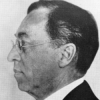Wassily Kandinsky

Wassily Kandinsky
Wassily Wassilyevich Kandinskywas an influential Russian painter and art theorist. He is credited with painting one of the first purely abstract works. Born in Moscow, Kandinsky spent his childhood in Odessa, where he graduated at Grekov Odessa Art school. He enrolled at the University of Moscow, studying law and economics. Successful in his profession—he was offered a professorshipat the University of Dorpat—Kandinsky began painting studiesat the age of 30...
NationalityRussian
ProfessionPainter
Date of Birth16 December 1866
CityMoscow, Russia
CountryRussian Federation
Painting took on a fabulous strength and splendor; the object was discredited as an indispensable element of the picture.
Colors produce a spiritual vibration, the impression they create is important only as a step towards this vibration.
Only just now awakening after years of materialism, our soul is still infected with the despair born of unbelief, of lack of purpose and aim.
With cold eyes and indifferent mind the spectators regard the work. Connoissers admire the "skill" (as one admires a tightrope walker), enjoy the "quality of painting" (as one enjoys a pasty). But hungry souls go hungry away. The vulgar herd stroll through the rooms and pronounce the pictures "nice" or "splendid." Those who could speak have said nothing, those who could hear have heard nothing.
Objects damage pictures.
There is, however, in art another kind of external similarity which is founded on a fundamental truth. When there is a similarity of inner tendency in the whole moral and spiritual atmosphere, a similarity of ideals, at first closely pursued but later lost to sight, a similarity in the inner feeling of any one period to that of another, the logical result will be a revival of the external forms which served to express those inner feelings in an earlier age.
The artist must be blind to distinction between 'recognized' or 'unrecognized' conventions of form, deaf to the transitory teaching and demands of his particular age.
The work of art is born of the artist in a mysterious and secret way. From him it gains life and being. Nor is its existence casual and inconsequent, but it has a definite and purposeful strength, alike in its material and spiritual life.
Whether the psychological effect of color is direct...or whether it is the outcome of association, is open to question. The soul being one with the body, it may well be possible that a psychological tremor generates corresponding one through association.
emotion that I experienced on first seeing the fresh paint come out of the tube... the impression of colours strewn over the palette: of colours - alive, waiting, as yet unseen and hidden in their little tubes...
Doubts must be resolved alone within the soul. Otherwise one would profane one's own powerful solution.
A parallel between color and music can only be relative – just as a violin can give warm shades of tone, so yellow has shades, which can be expressed by various instruments.
The sound of colors is so definite that it would be hard to find anyone who would express bright yellow with bass notes or dark lake with treble...
The circle is the synthesis of the greatest oppositions. It combines the concentric and the eccentric in a single form and in equilibrium. Of the three primary forms, it points most clearly to the fourth dimension.